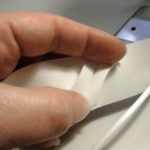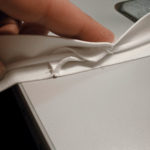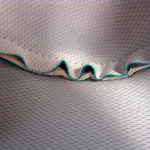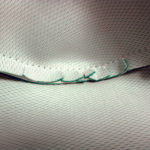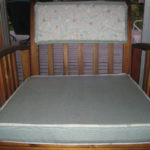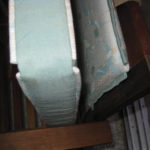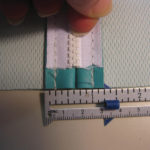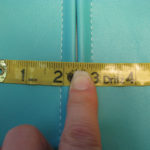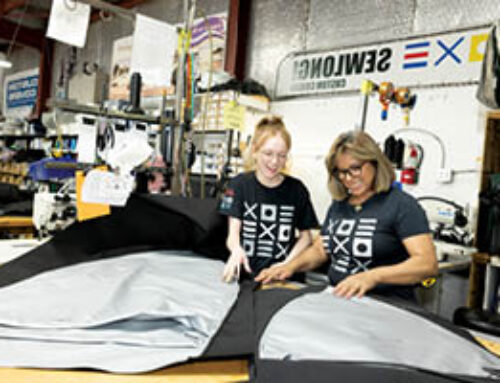Make a wrinkle-free corner on a cushion
I’m often asked about making a good-looking corner on a cushion. The answer depends on the cushion style and the materials you are using.
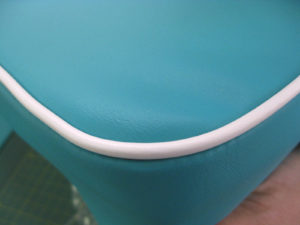 Let’s start with the basic, no-frills cushion: square, no sew foam applied, but with a welt cord.
Let’s start with the basic, no-frills cushion: square, no sew foam applied, but with a welt cord.
I make all my own cord. I have tried to use a welt foot but I do not like the result. The stitching is not close enough to the cord for my liking. When making the cord, use a long stitch so you can get a little stretch out of it if necessary, especially when doing corners.
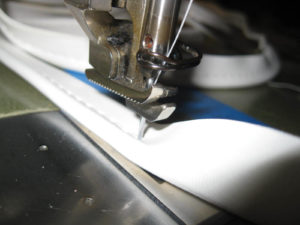 If the cord isn’t sewn in snug to the fabric, it will wrinkle when you try to bend it around a corner.
If the cord isn’t sewn in snug to the fabric, it will wrinkle when you try to bend it around a corner.
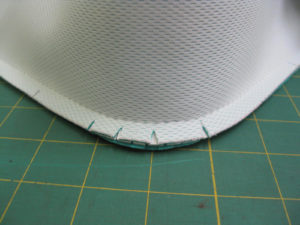 If you use 1¼–inch strips and 4/32 welt, you should end up with 3/8–inch seam allowance. Of course you will want to make adjustments for woven fabrics that fray, and use a bigger seam allowance.
If you use 1¼–inch strips and 4/32 welt, you should end up with 3/8–inch seam allowance. Of course you will want to make adjustments for woven fabrics that fray, and use a bigger seam allowance.
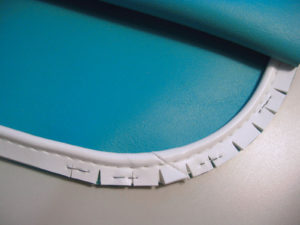 When using welt cord, I usually don’t try to make a 90–degree turn. I will generally cut the corners with a radius of about a nickel to make the cord lay smooth. I always make relief cuts in the cord when going around a corner—even when I have a larger radius. As you can see, you will have a much tighter and neater looking edge.
When using welt cord, I usually don’t try to make a 90–degree turn. I will generally cut the corners with a radius of about a nickel to make the cord lay smooth. I always make relief cuts in the cord when going around a corner—even when I have a larger radius. As you can see, you will have a much tighter and neater looking edge.
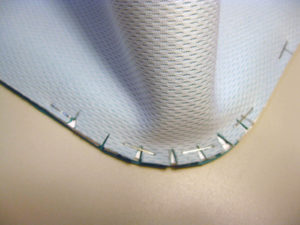 I must make a confession here: The machine I use has a shorter foot than most. This allows me to make sharper turns when sewing in tight spaces. However, no matter what kind of machine you use, if you can master sewing in welt cord without the cord foot, you will be able to make tighter corners. It is a matter of feeling your way through the fabric and knowing exactly where the needle will land.
I must make a confession here: The machine I use has a shorter foot than most. This allows me to make sharper turns when sewing in tight spaces. However, no matter what kind of machine you use, if you can master sewing in welt cord without the cord foot, you will be able to make tighter corners. It is a matter of feeling your way through the fabric and knowing exactly where the needle will land.
Here is another little trick to make the cushion look its best: when you turn the cushion right side out, look at how the fabric bunches up in the corner. Simply make a few nips in the seam allowance to let the excess fabric lay flat.
There are times when a cushion needs a little something extra, but welt cord just isn’t the answer. I use a strip of fabric to sew into the seam to give it a border without bulk. You can use this technique if you need to make 90–degree square corners. Do this by stopping the strip just short of the corner, making the turn, then starting a new strip of fabric for the next side.
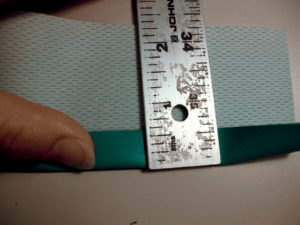 I have a very simple formula that will give you the exact size to cut the fabric for a finished zipper. When I am figuring the dimensions for all of the pieces I am going to cut for a new cushion, this is how to figure the zipper strips: generally, I will use a #5 chain zipper. The measurement from the center of the chain to the outer edge of the zipper tape is 5/8–inch.
I have a very simple formula that will give you the exact size to cut the fabric for a finished zipper. When I am figuring the dimensions for all of the pieces I am going to cut for a new cushion, this is how to figure the zipper strips: generally, I will use a #5 chain zipper. The measurement from the center of the chain to the outer edge of the zipper tape is 5/8–inch.
When figuring for foam compression, I do not subtract, as a rule, from the thickness of the foam. I add the thickness of the foam, my seam allowance for both sides, 1¼ inches (5/8-inch + 5/8-inch), and divide by two. So, for a 4–inch cushion with a 3/8–inch seam allowance and #5 zipper, the numbers are: 4 inches + 3/8 inch + 3/8 inch + 1¼ inch = 6 inches. Divide 6 inches by 2 and each side of the zipper strip needs to be cut 3 inches.
Fold over one edge of each strip 5/8; inch and match the edge of the zipper chain to the edge of the fold, and stitch on. I end up with a total width of 4¾ inches, exactly what I need.
Carol Racine is owner of Racine Design in Jacksonville, Fla.
 TEXTILES.ORG
TEXTILES.ORG 


